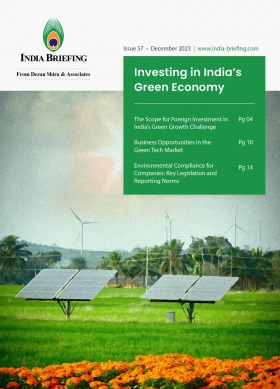Outlook for Sovereign Wealth Fund Investments in India
A surge in direct investments in India by global sovereign wealth funds has been noted recently. Specifically, on February 26, 2024, Goldman Sachs and Mubadala, the sovereign wealth fund of Abu Dhabi, entered into a US$1 billion private credit agreement aimed at co-investing in the Asia-Pacific region, with a particular focus on India.
Foreign investors from major economies are showing keen interest in becoming a part of India’s business ecosystem. India is predicted to be the fastest-growing G20 economy for the 2023-24 fiscal year. Tapping into its upward trajectory are various global investors, including those from the hydrocarbon-rich Gulf states. In October 2023, the United Arab Emirates (UAE) declared its intention to spend US$75 billion in India over a period of time, while Saudi Arabia established a US$100 billion investment objective in the nation.
Cashing in on the positive momentum, India’s Finance Minister, Nirmala Sitharaman, at the latest interim budget announced the extension of particular tax benefits for startups and investments from sovereign wealth or pension funds until March 31, 2025.
Policies such as Make in India, the Production-Linked Incentive Schemes, the liberalization of foreign direct investment (FDI) rules, and the setting up of an international financial services center (IFSC) at GIFT City have cumulatively created a pool of investment opportunities for international players. Major foreign investors are not only drawn towards setting up manufacturing units in India but also pooling capital through multiple financial channels.
What are sovereign wealth funds?
A sovereign wealth fund (SWF) is a state-owned investment fund funded by a country’s surplus reserves, including revenues from natural resources, trade surpluses, and excess budgeting. SWFs serve to benefit a country’s economy and citizens, often having targeted purposes such as acting as venture capital for the private sector.
Norway’s SWF discloses India investment portfolio
In 2023, the Norway Sovereign Wealth Fund, the world’s largest wealth fund with assets totaling US$1,576 billion, disclosed its complete portfolio. The market value of the fund’s investments in India experienced a significant upswing, reaching nearly US$24 billion by the end of December 2023. In the same period of 2022, the figure stood at US$17.12 billion.
Officially called the Government Pension Fund Global, the Norway SWF increased its investment size in terms of capital and the number of Indian companies. A year-on-year comparison showed that Norway’s SWF had invested in 459 Indian enterprises in 2023 as opposed to 416 entities in 2022. Jio Financial Services Ltd. was the largest of the new additions to the fund, with a final holding value of nearly US$100 million and an ownership stake of 0.56 percent in the business. The top two companies with the biggest ownership additions were Bajaj Electricals Ltd. and Home First Finance Co. With a 0.38 percent increase in ownership, Punjab National Bank’s holding value increased the fastest of all the companies, reaching 68 times its starting point.
Norway Sovereign Wealth Fund Allocation in India 2022-2023
|
Industry-segments |
2022 |
2023 |
|
Basic material |
53 |
55 |
|
Consumer discretionary |
66 |
73 |
|
Consumer staples |
27 |
27 |
|
Energy |
11 |
11 |
|
Financials |
77 |
84 |
|
Healthcare |
44 |
49 |
|
Industrial |
75 |
91 |
|
Real estate |
12 |
13 |
|
Technology |
31 |
32 |
|
Telecommunication |
12 |
11 |
|
Utilities |
8 |
13 |
|
Total |
416 |
459 |
Data: Norges Bank Investment Management (NBIM)
Besides the 459 companies, the complete disclosure of the Norway SWF portfolio also mentions two more investments, i.e., the Government of India and Reliance Industries, thereby taking the total investment tally up to 461.
India becoming a hot spot for wealth fund investors
Among the most recent finance commitments from a sovereign wealth fund is the announcement that the Abu Dhabi Investment Authority (ADIA) will establish a US$4-5 billion fund for investments in India. The largest sovereign wealth fund in the UAE, ADIA has been given the green light to operate through the tax-neutral finance hub of GIFT City in the state of Gujarat.
Attention is also coming in from European SWFs – the new sovereign wealth fund set up by Ireland has identified India as a potential investment destination. The 100-billion-euro (US$106 billion) Future Ireland Fund is designed to address future challenges to its economy emanating from rising healthcare and pension costs due to an aging population and climate change. The government of Ireland is mandated to allocate 0.8 percent of the country’s GDP to this Fund annually from 2024 to 2035. In January 2024, Ireland’s Finance Minister, Michael McGrath, indicated that while the investment mandate of the Future Ireland Fund is yet to be finalized, it is likely to be primarily based on global investments.
On the Southeast Asian front, Malaysia’s sovereign wealth fund, Khazanah Nasional Berhad, is reportedly considering leading a US$400 million fundraising round for the Indian multinational hospitality chain of leased and franchised hotels, homes, and living spaces Oyo Hotels & Homes Pvt.
India’s MSCI surge: Record weightage, bond market buzz
India has improved its market performance as per findings published by the Morgan Stanley Capital International (MSCI) Index. The index provider increased India’s weightage in its Global Standard (Emerging Markets) index to a record high of 18.2 percent in its February 2024 review. Currently, India holds the second-highest weight in the MSCI Global Standard index, surpassed only by China.
It is worth noting that India’s weightage in the index has nearly doubled since November 2020. According to insights from Nuvama Alternative & Quantitative Research, this surge is attributed to India’s standardized foreign ownership limit (FOL) in 2020, the consistent uptrend in domestic equities, and the relatively weaker performance of other emerging markets. The research group also estimates that the country could potentially attract up to US$1.2 billion in passive foreign flows.
The inclusion of Indian sovereign bonds in JPMorgan Chase & Co.’s global debt indexes starting June this year has also boosted the country’s appeal to financial investors.
According to data provided by Bloomberg, the number of issuances by sovereign, supranational, and agency organizations that gave investors exposure to India reached a record in 2023. The value of these offerings reached a five-year high of US$3.2 billion.
Foreign investors are increasing their exposure to India through instruments like supranational bonds and swaps ahead of India’s inclusion in global bond indexes. A stable growth of the Indian economy, aligned with consistent economic policies and political stability, should pique the interest of new foreign investors.
Tax exemption provided in India for SWF
Since 2020, India has implemented a 100 percent income tax exemption for SWFs. As to the Central Government of India’s statement dated November 2020, the first fund to benefit from this exemption under the Income Tax Act of 1961 was the UAE SWF, ADIA.
Eligibility requirements for sovereign wealth funds in India
Any SWF must comply with the following rules:
- It must be wholly owned and controlled, either directly or indirectly, by the government of a foreign country.
- It must be set up and regulated as per the laws of that foreign country.
- Ensure that the earnings of the SWF are not credited to any private person. It is credited to the accounts of the government of the foreign country or any account as designated by them.
- The fund does not undertake any commercial activity within or outside India.
- The assets of the fund will vest with the foreign government upon dissolution.
- It is notified by the Central Government, in the Official Gazette, for the purposes of exemption in India.
India has been vocal in its ambition to further expand its foreign investment market. In its Union Budget 2020, the nation proposed a 100 percent tax exemption on dividend, interest, and long-term capital gains income arising from overseas SWF investments in India.
This new exception was introduced via the Finance Act of 2020, and it applies to SWFs that are active in the country and have qualified investments in specific infrastructure firms.
The Central Board of Direct Taxes (CBDT) of India has broadened the definition of “infrastructure” to encompass sectors like water, electricity, sanitation, transportation, telecommunication, and social and commercial infrastructure (such as medical facilities, tourist destinations, and educational establishments). The enlarged scope now includes every subsector listed in the 2018 version of the Harmonized Infrastructure Master List.
A minimum three-year period between April 1, 2020, and March 31, 2024, was required for the investment to be made and maintained, and this exemption was extended earlier this year through March 31, 2024.
Foreign Portfolio Investor (FPI) Classification in India
India categorizes FPI investors into three primary groups:
- Category I (or low risk): It involves financial instruments supported by the Indian government, such as government bonds, funds owned by the Indian state, sovereign wealth funds, and others.
- Category II (or moderate risk): This encompasses bank deposits, mutual funds, insurance policies, pension funds, and similar financial assets.
- Category III (or high risk): This category includes all other foreign portfolio investments not covered by the first two categories, such as charitable trusts or endowments.
Performance of Sovereign Wealth Funds Globally in 2023 (in US$)
|
Rank |
Profile |
Total assets |
Type |
Region |
|
1 |
Norway Government Pension Fund Global |
1,548,145,071,000 |
Sovereign Wealth Fund |
Europe |
|
2 |
China Investment Corporation |
1,350,000,000,000 |
Sovereign Wealth Fund |
Asia |
|
3 |
SAFE Investment Company |
1,090,000,000,000 |
Sovereign Wealth Fund |
Asia |
|
4 |
Abu Dhabi Investment Authority |
993,000,000,000 |
Sovereign Wealth Fund |
Middle East |
|
5 |
Kuwait Investment Authority |
803,000,000,000 |
Sovereign Wealth Fund |
Middle East |
|
6 |
Public Investment Fund |
776,657,356,350 |
Sovereign Wealth Fund |
Middle East |
|
7 |
GIC Private Limited |
770,000,000,000 |
Sovereign Wealth Fund |
Asia |
|
8 |
Hong Kong Monetary Authority Investment Portfolio |
514,223,020,000 |
Sovereign Wealth Fund |
Asia |
|
9 |
Qatar Investment Authority |
501,000,000,000 |
Sovereign Wealth Fund |
Middle East |
|
10 |
Temasek Holdings |
492,208,248,000 |
Sovereign Wealth Fund |
Asia |
Outlook
When it comes to cross-border investments, a rise in direct investments in a country signifies a higher level of confidence. Recent trends show SWFs are investing across various Indian industries, particularly in asset management, healthcare facilities, hospitals, film and entertainment, and renewable energy projects such as solar and wind power.
Financially stable SWFs are eager to invest in Indian businesses and real estate, spanning from startups to real estate projects. These wealth funds are presenting formidable competition to private equity firms in India’s asset acquisition market.
Moreover, India is outpacing China in terms of cross-border direct investments from SWF funds, even if the US is still a major destination for cash from sovereign investors.
Not only are there new foreign players expressing investment interest in the Indian market but established direct sovereign wealth fund investors like the Kuwait Investment Authority, ADIA, QIA, GIC Private Limited, Norway Government Pension Fund Global (Norges Bank Investment Management), Temasek Holdings, and GIC Private Limited continue to maintain their foothold.
About us
India Briefing is produced by Dezan Shira & Associates. The firm assists foreign investors throughout Asia from offices across the world, including in Delhi and Mumbai. Readers may write to india@dezshira.com for more support on doing business in India.
We also maintain offices or have alliance partners assisting foreign investors in Indonesia, Singapore, Vietnam, Philippines, Malaysia, Thailand, Bangladesh, Italy, Germany, Australia, and the United States.
- Previous Article Mauritius Government Amends its Double Tax Treaty with India to Align with BEPS MLI
- Next Article India’s Stock Market Expected to Reach US$10 Trillion Market Value by 2030









